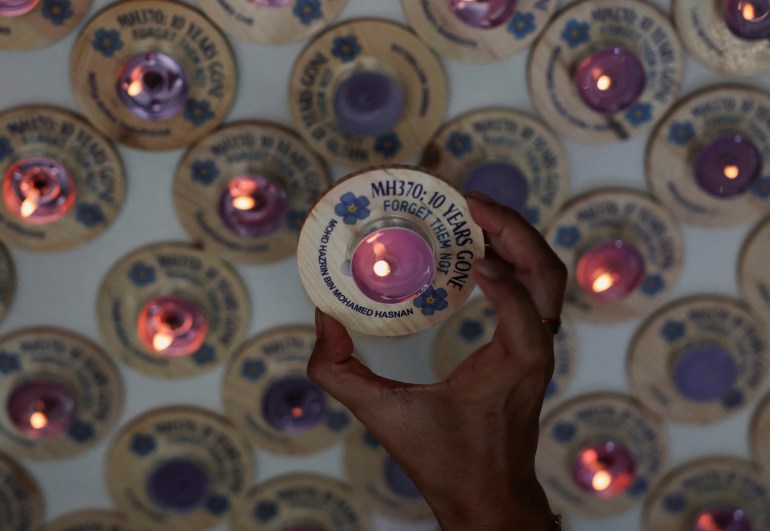Ten years after MH370 disappeared, what do we know?
Despite extensive air and sea searches, the Boeing 777-200, which disappeared on a flight to Beijing, has not been found.
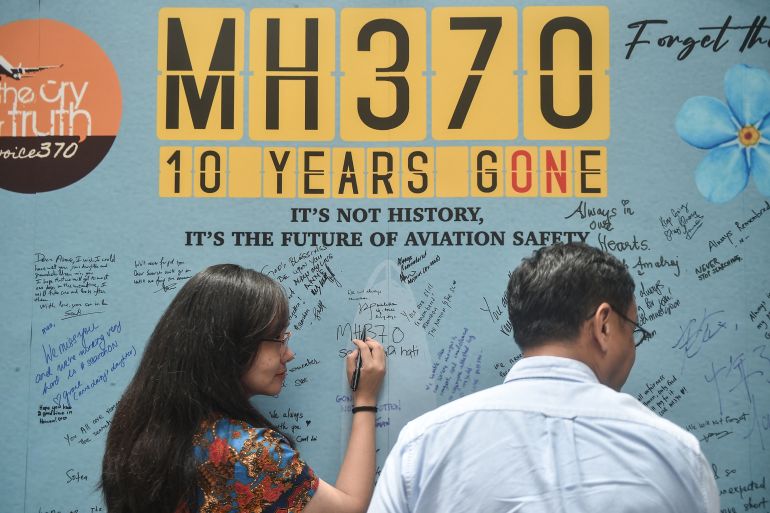
Kuala Lumpur, Malaysia – MH370 has now been missing for 10 years.
The Malaysia Airlines Boeing 777-200 was on an overnight flight from Kuala Lumpur to Beijing with 239 passengers and crew on board when it disappeared.
Keep reading
list of 4 itemsMalaysia could renew search for MH370 plane 10 years after it vanished
Singapore apologises after comedian’s MH370 joke
New probe over vanished Malaysia Airlines plane urged in China court
Its last transmission was from Captain Zaharie Ahmad Shah as the twin-engined aircraft moved into Vietnamese airspace in the early hours of March 8, about 40 minutes after leaving Kuala Lumpur.
“Good night Malaysian three seven zero,” he said, as he bade farewell to Malaysian air traffic control.
Then all went quiet.
But while the plane disappeared from radar, it apparently continued flying for hours.
Early searches of the South China Sea were wrapped up as attention shifted to a remote part of the southern Indian Ocean, where satellite pings suggested the plane came down after running out of fuel.
Hundreds of millions of dollars were spent on scouring the seas without any sign of debris.
A few small pieces of fuselage have been found – including a flaperon, which forms part of the wing – washed up on beaches on Indian Ocean islands and in eastern Africa, but the world knows little more than it did in 2014.
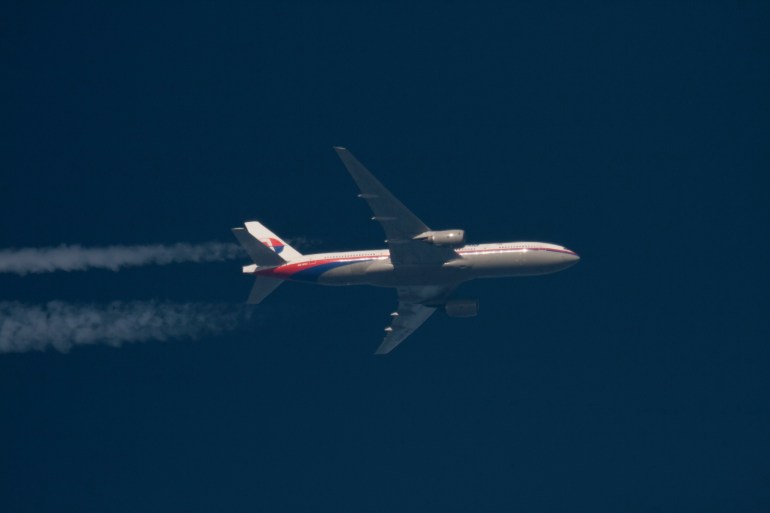
MH370 has evolved into one of the greatest mysteries of modern aviation.
Here is all you need to know.
Who and what was on board?
There were nationals of more than a dozen countries on board the lost plane, although more than half were from China.
The passengers included a group of prominent Chinese artists who had been showing their calligraphy in Kuala Lumpur, two Iranians travelling on fake European passports, an Indonesian heading to Beijing to start a new job, a Malaysian couple on their honeymoon, young families with children and a stunt double for Jet Li.
In the cockpit, Zaharie, a 53-year-old father of three, had joined Malaysia Airlines in 1981 and was one of its top pilots. Beside him was Fariq Hamid Ahmad. The 27-year-old has just qualified to co-pilot the 777.
In the cabin, the Malaysian crew was led by supervisor Patrick Gomes who had worked for the airline for 35 years.
When the plane disappeared, investigators also scrutinised its cargo. In the hold, there were found to be shipments of electronics including lithium batteries, as well as walkie-talkies.
There was also a large consignment of mangosteens, a sweet tropical fruit known for its purple skin.

What happened when MH370 went missing?
When Malaysians woke up to the news that the plane had gone missing, they were shocked. Despite perennial problems with its finances, the national carrier had a good safety record and a place in many a Malaysian heart.
As the hours passed and no one seemed to have much idea of what had happened, shock turned to disbelief. In Beijing, tearful relatives demanded to know what had happened to their loved ones.
Amid the lack of answers, officials from Malaysia Airlines, civil aviation authorities and the Malaysian government came under unprecedented international scrutiny.
Then it became clear that the aircraft had never entered Vietnamese airspace.
Shortly after Zaharie signed off, MH370 went dark. Its transponders were turned off and its tracking system was somehow disabled. Military radar showed the plane left its flight path to fly back over northern Malaysia and Penang island, and then out into the Andaman Sea towards the tip of the Indonesian island of Sumatra.
The final sighting on military radar was on March 8 at 2:22am Malaysian time (18:22 GMT, March 7). From there, the aircraft turned south – out into the vast expanse of the Indian Ocean.
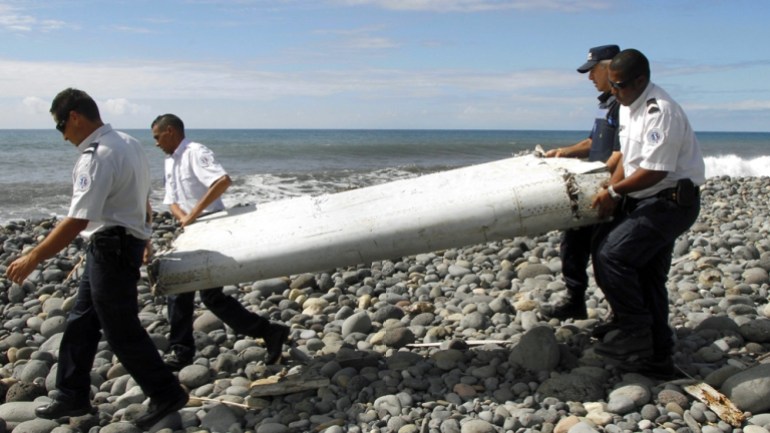
What has been done to find it?
In the immediate aftermath of the plane going missing, Malaysia coordinated a search that involved more than two dozen countries.
While initial efforts focussed on the South China Sea and the Andaman Sea, attention turned to the southern Indian Ocean when the military radar findings emerged on March 12, and the British telecommunications firm Inmarsat shared automated connections between its satellite and the 777 that suggested the plane could be somewhere along an arc of coordinates in the southern Indian Ocean.
An initial aerial search of the ocean began on March 18 and covered an area of 4.5 million square kilometres (1.7 million square miles).
The multinational effort, led by Australia, failed to find any sign of the plane and ended after six weeks.
Attention then turned to the inhospitable seabed, some 2,800km off the coast of Western Australia
The search, covering some 120,000 square kilometres (46,332 square miles), involved ships, submarines and aircraft, and cost $147m.
The notoriously poor weather of the southern Indian Ocean added to the challenges, and the effort was suspended in 2017.
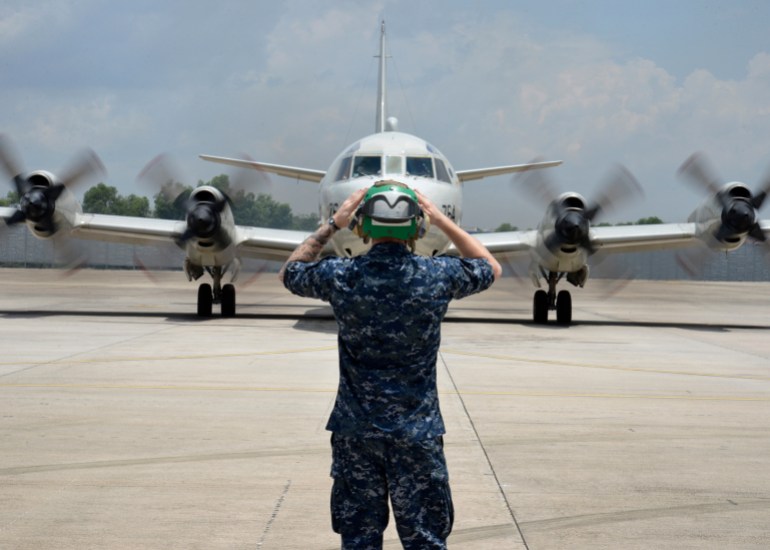
While the team discovered shipwrecks dating from the 19th century, they found no sign of the plane.
A US firm, Ocean Infinity, then took up the challenge, working on a “no find, no fee” basis.
That search – covering more than 112,000 square kilometres (43,243 square kilometres) just north of the initial search area – also failed to turn up any trace of the plane.
What might have happened to MH370?
Malaysia’s official report into the disappearance, released in 2018, found that while foul play was probably involved, it was not possible to say who had turned off the transponders and turned the plane around.
“The answer can only be conclusive if the wreckage is found,” Kok Soo Chon, head of the MH370 safety investigation team, told reporters at the time.
Zaharie came under suspicion.
In 2017, a 440-page report by the Australian Transport Safety Bureau (ATSB) showed that the pilot had flown a route on his home flight simulator six weeks before MH370 disappeared that was “initially similar” to the one actually flown on March 8.
Kok said the investigators examined the history of the pilot and the first officer, and they were satisfied with their background, training and mental health.
“We are not of the opinion it could have been an event committed by the pilots,” he said, but added investigators were not ruling out any possibility since the in-air turn back was done manually and the systems in the plane had been manually turned off.
“We cannot exclude that there was an unlawful interference by a third party,” Kok said.
The lack of any concrete information has enabled conspiracy theories to flourish.
Will the plane ever be found?
Many people struggle to understand how a Boeing 777-200 – some 64 metres (210ft) long, with a wingspan of nearly 61 metres (200ft) and a tail 18.5 metres (61ft) high – could have gone missing.
But the Indian Ocean is the world’s third largest, and the water is incredibly deep – some 4,000 metres in the places being searched.
Charitha Pattiaratchi is a professor of coastal oceanography at the University of Western Australia, where a team of researchers carried out drift analysis that suggested debris from the plane would wash up on the shores of East African nations if it was along the coordinates that the Inmarsat pings suggested.
He believes that advances in technology over the past 10 years, as well as the conditions in the ocean itself, suggest there is a “high probability” MH370 might finally be found.
“In the area where the search is to take place, the ocean is around 4,000 metres deep,” Pattiaratchi wrote in the Conversation newsletter earlier this week. “The water temperatures are one to two degrees Celcius [33.8 – 35.6 degrees Fahrenheit], with low currents. This means that even after 10 years, the debris field would be relatively intact.”
It is not clear whether it would still be possible to analyse the plane’s black boxes after so many years beneath the sea, but finding MH370 would bring some relief to families who have spent years waiting for answers.
